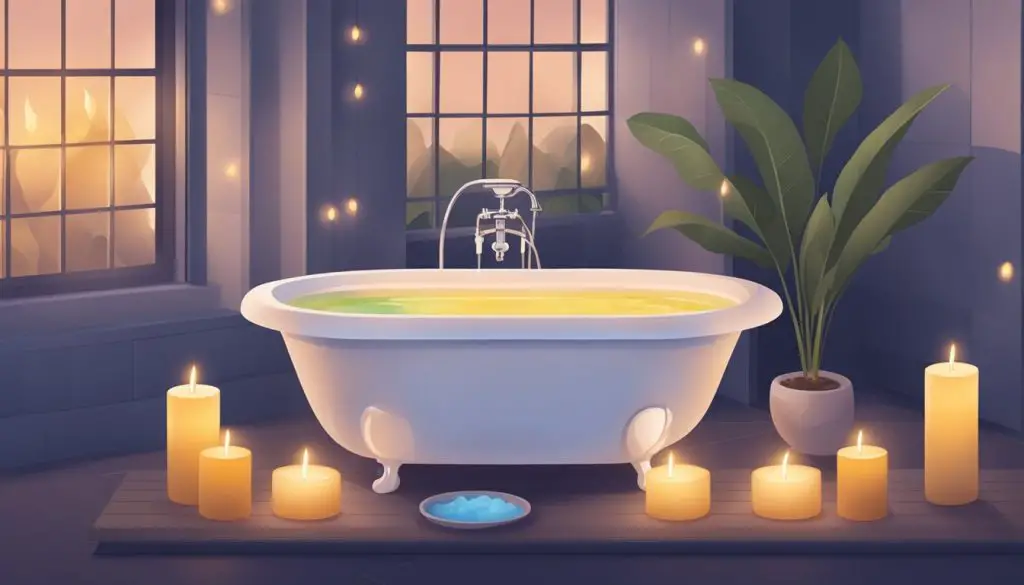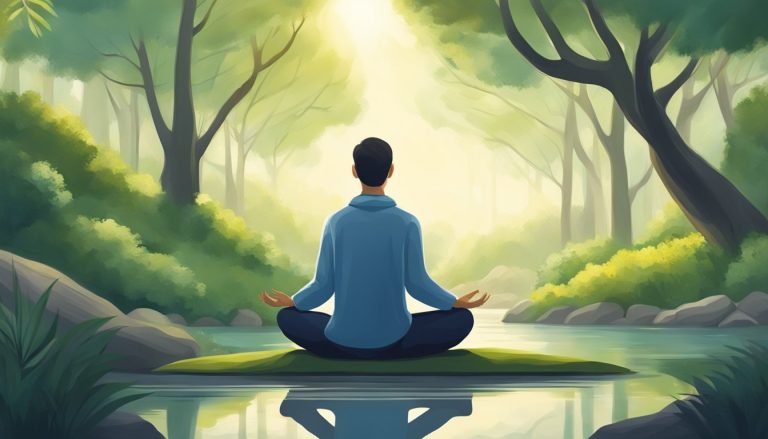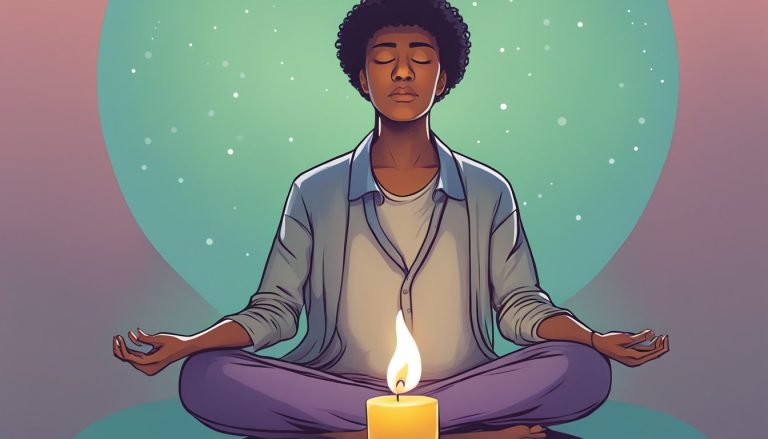How to Meditate in the Bathtub: A Guide to Relaxing Soaks
Meditating in the bathtub combines the relaxation properties of a warm bath with the centered calm of traditional meditation.
I find this practice to be an effective way of managing stress and cultivating a sense of peace.
When preparing for a bathtub meditation, I ensure the environment is conducive to relaxation. I set the water temperature to a comfortable warmth that isn’t too hot or cold, and I dim the lights. I also light candles to create a serene ambiance.

Once the bath is prepared, I focus on integrating mindfulness techniques as I settle into the water. Breathing exercises and guided imagery become my tools to deepen the meditative state. They allow the stress of the day to dissipate with each exhale.
Viewing this time as a sacred ritual, I aim to create a routine that signals to my body and mind that this is a moment for unwinding and reflection.
Key Points
- Bathtub meditation merges the soothing effects of a warm bath with mindfulness practices.
- A calming environment and consistent routine enhance the quality of the meditation experience.
- Strategic relaxation and meditation techniques facilitate stress relief and promote inner calm.
Table of Contents
Preparing the Perfect Bath Environment

To create a sanctuary for meditation in my bathroom, I focus on three vital aspects that appeal to the senses: the ambiance around my bathtub, the temperature of the water, and the use of aromatherapy.
Let’s dive into each of these components to transform a simple bath into a meditative retreat.
Setting the Ambiance
For me, setting the right ambiance is crucial. I use candles to provide a soft, warm light that helps initiate a state of calmness.
Dimming the bathroom lights and placing candles at different spots around the tub allows shadows and light to dance together, creating a serene visual effect. I make sure the room is quiet to allow for an inner silence to develop.
Sometimes, I might add a bubble bath for an added touch of tranquility, watching the bubbles rise and fall to help soothe my mind.
Optimizing Water Temperature
Warm water is key to physical relaxation, which in turn supports mental release. I ensure that the water temperature is comfortably warm but not too hot. Typically, this is between 98°F to 102°F (37°C to 39°C). The warmth should be soothing, not scalding, as it helps to relax my muscles and sets the stage for deeper meditation.
Using Aromatherapy for Enhanced Relaxation
Aromatherapy plays an integral role in deepening my meditative experience. I select essential oils with soothing scents such as lavender or eucalyptus to enhance relaxation.
Sometimes, I might use a bath bomb that’s infused with essential oils to create a multisensory experience. The vapors from these oils stimulate my senses and promote a calming atmosphere, which is conducive to meditation.
Meditation Techniques for the Bathtub
Meditating in the bathtub can be a transformative experience, combining the warmth and comfort of the water with inner peace and relaxation. Here, I’ll guide you through distinct techniques to enhance your bath meditation practice.
Focusing on Breath and Sensation
When I meditate in the bathtub, I find focusing on my breath and the sensations of the water to be particularly grounding.
Deep breathing is a simple yet powerful technique where I inhale deeply, feel my diaphragm expand, and exhale slowly, concentrating on the sensation of the breath moving through my body.
I also practice a full body scan, starting from my toes and moving upwards, noting each part of my body that’s in contact with the warm water. This allows me to anchor myself in the present moment and the physical experience of bathing.
Incorporating Mindfulness Meditation
For me, mindfulness meditation during a bath involves staying present with each moment. I pay close attention to the sensations of my body submerged in water, the temperature on my skin, the sound of water lapping, and the scent of any bath products I’m using.
Mindfulness in the bath helps me observe my thoughts and feelings without judgment, allowing them to come and go like ripples in the water, which deepens my relaxation and sense of focus.
Utilizing Guided Meditation and Apps
I sometimes enhance my bathtub meditation by using guided meditation recordings or meditation apps.
These tools can lead me through visualization meditation, helping me imagine a serene landscape or journey that complements the soothing effect of the bath.
With the assistance of soft-spoken narrators and thematic background music, guided meditation narratives available in these apps support a more structured and varied meditation experience.
Creating a Routine for Bathtub Meditation
Meditating in the bathtub combines relaxation and mindfulness to enhance my self-care routine. Establishing regular sessions and purposeful self-care practices allows me to reduce stress and promote mental health.
Scheduling Regular Sessions
Frequency: I find it effective to meditate in the bath 2-3 times per week. Consistency is key to reaping the benefits.
Timing: I schedule my bathtub meditations when I know I won’t be interrupted. Usually, this is either in the early morning or just before bed.
- Weekday Evenings: To unwind after a busy day.
- Weekend Mornings: When I have extra me-time.
Calendar Alerts: I set reminders on my phone to make sure I don’t skip my scheduled baths.
Incorporating Meditation into Your Self-care Routine
Self-Care Integration: Bathtub meditation is not just about soaking; it’s an act of mindfulness.
I make sure that the environment in my bathroom is comfortable and conducive to relaxation.
- Temperature: I ensure the water is warm but not too hot to avoid drowsiness or discomfort.
- Ambiance: Dimming the lights and playing soft, soothing music or nature sounds helps me create a serene space.
- Props: I sometimes add bath salts or essential oils aimed at stress relief for an enhanced experience.
Enhancing Your Meditation Experience

To transform my bath into a sanctuary of peace, I focus on creating an environment that promotes relaxation and health.
Selecting Additives for Relaxation and Health
Essential Oils: I often add a few drops of lavender essential oil to the water. It’s renowned for its ability to soothe the nervous system. Here’s how I use them:
- Lavender: Promotes relaxation and improves sleep.
- Chamomile: Reduces stress and eases tension.
Bath Salts: Epsom or Himalayan salts are my go-tos for muscle relaxation and overall detoxification.
- Epsom Salts: Provide magnesium, essential for decreasing inflammation.
- Himalayan Salts: Infuse the bath with minerals and promote skin health.
Herbal Additions:
- Chamomile: The petals can be scattered in the bathwater for a calming effect.
- Green Tea: Sometimes, I’ll brew a strong pot of green tea and add it to my bath for its antioxidant properties.
To keep hydrated, I make sure to have a glass or cup of herbal tea nearby, completing the atmosphere for a holistic relaxation session.
Including Additional Relaxation Techniques
Meditation Position: I choose a comfortable position, ensuring I have a supportive bath pillow behind me. I also focus on maintaining a good posture to help with deeper breaths and aligning with my parasympathetic nervous system.
Mantras and Breathing: I often repeat a mantra silently in my head to focus my thoughts. Pairing this with deep breathing techniques enhances my meditative state.
Privacy and Peace: I’ll hang a “Do Not Disturb” sign on the door to ensure privacy for uninterrupted reflection.
Complementary Practices:
- Face Mask: Applying a nourishing face mask allows me to combine skincare with relaxation.
- Yoga: Sometimes, before slipping into the bath, I’ll do a few gentle yoga stretches to start the relaxation process.
Frequently Asked Questions
What steps should I follow for a guided meditation while in the bathtub?
I typically start by setting the temperature to a comfortable warmth and ensuring the bathroom is free from distractions.
Next, I choose a guided meditation. I do this either through an app or an audio track. Then, I ease into the tub and close my eyes to follow the verbal instructions.
Can I enhance my bath meditation experience with music, and if so, how?
Adding music to my meditation routine in the bathtub can be soothing.
I personally prefer instrumental tracks or nature sounds played on a waterproof speaker. The music should be soft enough to relax me, yet audible over the water.
What are some tips for turning a regular bath into a healing meditation session?
I make a regular bath into a healing session by adding Epsom salts or essential oils for their therapeutic properties.
Then, I focus on my breath and visualize stress washing away. This creates both a physical and mental restoration.
How can I incorporate mindfulness techniques during my bath time?
To incorporate mindfulness, I pay attention to the sensation of the water on my skin, the warmth enveloping me, and the sounds in the environment.
All the while, I also practice deep, even breathing to ground me in the present moment.
In what ways can sound baths be integrated into a bathing routine?
During my bathing routine, I often include sound baths by playing recordings of singing bowls, gongs, or other resonant instruments.
The harmonic vibrations contribute to a deeper state of meditation and relaxation in the bath.
Are there specific breathing exercises recommended for meditation in the bathtub?
Yes, I sometimes use the 4-7-8 breathing technique. With this technique, I inhale for four counts, hold the breath for seven, and exhale slowly for eight counts.
This can help induce relaxation and is easy to do while soaking in the tub.







